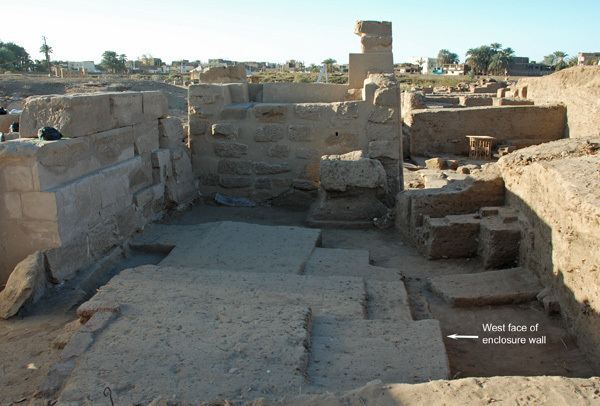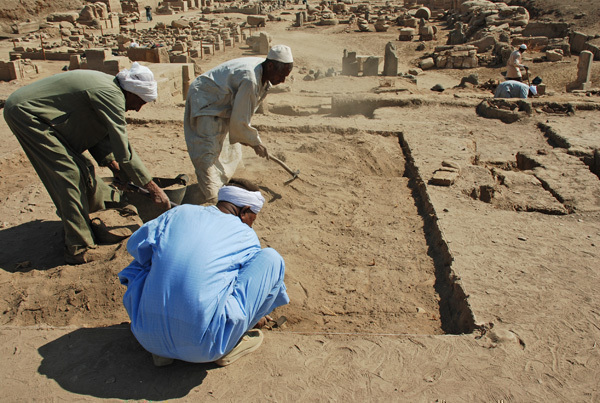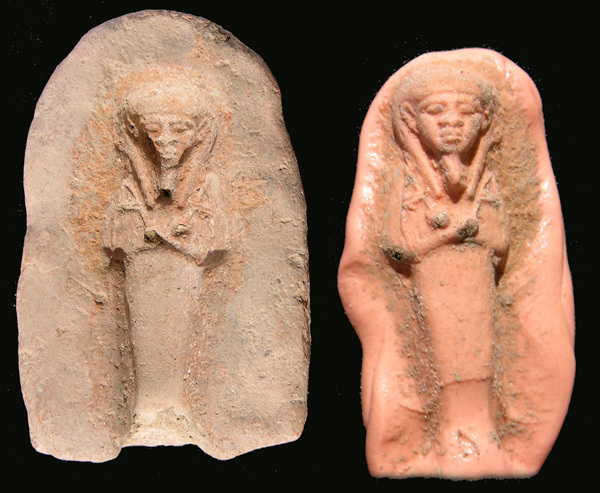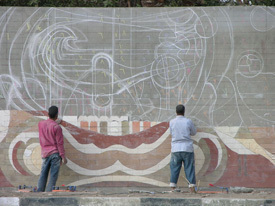More brick

A view south from the precinct’s north enclosure wall of the whole area where we are now working. At the left are Chapel D and the Taharqa Gate; in the center the paving of the approach to the gate; and in the upper right the two squares we have opened on the high ground west of the gate.


Before I get to the work, I want to welcome back William and Elsie Peck, who arrived this week. Bill has been with the Mut Expedition longer than anyone except me, while Elsie joined us in 1979, which was also Mary’s first year. Bill’s first job this season is to map the new paving west of the Taharqa Gate. Elsie once again has taken on keeping the digging records, beginning with what Mahmoud Abbadi is doing in the corridor south of the Taharqa Gate.


The corridor at the end of the week, looking south (left) and north. The limestone chip layer at the north end now extends almost the full length of the corridor and is mixed with pieces of sandstone and pottery. What we had thought might be two brick walls on the west side of the corridor (on the right in the left picture) turned out to be a single wall whose northern end had been robbed out. Behind the meter stick in the left picture is a more organized grouping of stone fragments that seems to be an intentional blocking of the corridor at the south end of this wall.

Mary photographing the corridor in the early morning. Photographing from the top of a ladder is not her favorite activity, but sometimes it is necessary. I thank Jaap for this picture.

We expanded the square north of the Taharqa Gate and now have the full width of the gate wall from the first room of Chapel D (left) to the wall’s west face.

On the east side of the expanded enclosure wall square we found this curious baked brick feature set into the east side of the wall. Of the south and north walls only a few bricks remain, so we will never know what it was. Its presence, though, suggests there may have been a corridor (or at least a space) between the rear rooms of Chapel D and the Taharqa Gate wall.

The square on the high ground west of the gate, where Abdel Aziz found a mud brick wall last week, has produced no architectural remains since then, which doesn’t surprise us. The area is part of the same mass of debris we found last season, filling the space between the north and south boundary walls of the approach to the Taharqa Gate to a depth of almost 3 meters. We hope that the debris isn’t that deep in this square, which abuts an area of Ptolemaic and early Roman Period habitations.

On Saturday we opened a new square just south of Abdel Aziz to try to find more of the mud brick buildings discovered last year. You can see some of them in the upper right corner of this photograph. Abdullah struck mud brick almost immediately, only about 10 cm below the modern surface.

The same area at the end of work on Thursday, looking east. We already have at least 2 phases of brick walls (foreground), an area of confused brick in the southeast corner (under the meter stick) and in the northeast corner a patch that so far is just loose earth. Have I mentioned that mud brick is complicated?

Our most interesting find of the week was this mould for a figure of Osiris. Even though the figure is only about 2 inches tall, it is very finely carved with a great deal of detail. The only problem is that it did not turn up in the areas we are excavating: I found it on the ground behind a gate in the Mut Temple’s first pylon one day this week while checking inscriptions.


In 2007, local artists created a mosaic-decorated wall along the road to Karnak in front of a rundown cemetery for foreigners who died in Luxor; here it is in progress. During last year the city government decided to move the residents to a new cemetery and create a lovely public park on the grounds (right).

Among the park’s most charming features are groups of whimsical sculptures, my favorite being this cluster of mushrooms.

Richard Fazzini joined the museum as Assistant Curator of Egyptian Art in 1969 and served as the Chairman of Egyptian, Classical and Ancient Middle Eastern Art from 1983 until his retirement in June 2006. He is now Curator Emeritus of Egyptian Art, but continues to direct the Brooklyn Museum’s archaeological expedition to the Precinct of the Goddess Mut at South Karnak, a project he initiated in 1976. Richard was responsible for numerous gallery installations and special exhibitions during his 37 years at the museum. An Egyptologist specialized in art history and religious iconography, he has also developed an abiding interest in the West’s ongoing fascination with ancient Egypt, called Egyptomania. Well-published, he has lectured widely in the U.S. and abroad, and served as President of the American Research Center in Egypt, America’s foremost professional organization for Egyptologists.
